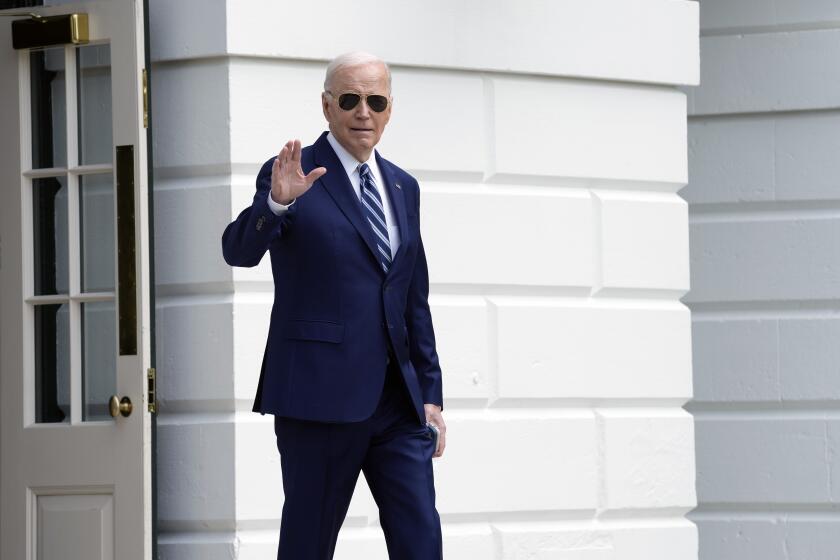Brooke Astor, 105; N.Y. socialite, philanthropist gave away $200 million
Brooke Astor, the itinerant soldier’s daughter who married her way into the top echelon of Manhattan society and then gave away a fortune, died Monday. She was 105.
Astor died of pneumonia at Holly Hill, her more than 60-acre country estate overlooking the Hudson River in New York, said Kenneth Warner, a lawyer for her son, Anthony D. Marshall.
In a life with many chapters, Astor’s final days took on the air of a Victorian tragedy as her grandson Philip Marshall accused his octogenarian father of taking advantage of the frail philanthropist and failing to ensure that the once fiercely independent Astor received proper care, including medications.
In late July 2006, a Manhattan Supreme Court judge removed Marshall, a onetime Broadway producer and former U.S. ambassador to Kenya, as her legal caretaker in favor of Astor’s longtime friend and society protege Annette de la Renta, wife of the fashion designer Oscar de la Renta. Astor was then hospitalized briefly and, upon her release, went to her Westchester County estate, where she remained until she died.
Marshall released a statement through his lawyer saying, “I have lost my beloved mother, and New York and the world have lost a great lady. She was one of a kind in every way. Her tombstone will be inscribed with the words she specifically asked for: ‘I had a wonderful life.’ ”
The family dispute is destined to flare up with her death. Under the agreement that removed Marshall as guardian, legal disputes over the will -- which allegedly includes a forged amendment -- are to be wrangled over in New York Surrogate’s Court.
The scandal, and the underlying fight over money, contrasts sharply with Astor’s legacy as a leading light in Manhattan’s high society -- her dinner parties were known for drawing together the power brokers of politics and business -- and the doyenne of New York philanthropy, a role that she often wryly observed had turned her into “a public monument.”
In a statement Monday, New York Mayor Michael Bloomberg called Astor “a quintessential New Yorker and one of the great philanthropists of our time. Tens of thousands of New Yorkers were the beneficiaries of Mrs. Astor’s good will and kind nature, many unaware of the origins of the donations.”
Astor’s wealth came from Vincent Astor, her third and last husband and a direct descendant of John Jacob Astor, believed to be the nation’s first millionaire, who made his post-Revolutionary War fortune in fur trading and early New York City real estate.
His descendants, John Jacob Astors II, III and IV, turned that family stake into a formidable fortune in the 19th century, paralleling New York City’s emergence as a world center and integrating the family name into Manhattan itself, from the Waldorf-Astoria Hotel to Astor Place.
John Jacob Astor IV was aboard the Titanic in 1912 when it sank in the icy North Atlantic, and with his death his eldest son, Vincent, left Harvard College to take control of the family fortune, estimated then at $87 million.
Upon Vincent Astor’s death in 1959, Brooke Astor received $2 million and the interest income from an additional $65 million, about half of his estate, the principal of which will be disposed of in her will.
Vincent Astor willed the other half of his estate to his namesake foundation devoted to “alleviating human misery,” and over the next three decades Brooke Astor doubled its holdings even as she gave away, ultimately, nearly $200 million to New York City organizations and projects that she had first personally inspected for suitability.
For Astor, dispersing her husband’s wealth within New York City was akin to scattering the ashes of the dead over a homeland. The money, she reasoned, had been made mostly in New York City, so that’s where it should go.
Astor was a lifelong reader and the author of four books. Reflecting that interest, the New York Public Library was a prime beneficiary of her largesse. But Astor’s projects ran the gamut, including creating outside “living room” parks for public housing complexes, renovating subway stations, paying for pet care for low-income elderly New Yorkers and providing the recently homeless with furniture for new apartments.
Astor was born Roberta Brooke Russell on March 30, 1902, in Portsmouth, N.H., where her father, a Marine, was stationed. An only child, she was reared mostly overseas -- China, Panama, Santo Domingo and Hawaii -- as her father moved from posting to posting (he eventually served as high commissioner to Haiti and was the Marine Corps commandant from 1932-34).
Astor attended a series of schools in a number of countries, experiences that gave her an unusually broad exposure to the world. She recalled in her 1962 memoir, “Patchwork Child,” watching the funeral procession for China’s Empress Dowager Cixi after her death in 1908. Astor’s exposure to the world informed an empathy that came to define her adult personality, said Vartan Gregorian, whom Astor befriended when he was appointed president of the New York Public Library in 1981.
“She had a genuine compassion without condescension,” said Gregorian, now president of the nonprofit Carnegie Corp. “That came, I guess, from her upbringing. . . . She was very generous and always polite. She had class in terms of not wealth but comportment, behavior, attitude and style.”
At the end of World War I, Astor attended a prom at Princeton University and met J. Dryden Kuser, a member of a prominent New Jersey family, and they married in 1919, when she was 17. Astor later described the marriage as disastrous, though it produced her only child and introduced her to New York society.
Astor first appeared in the New York Times’ Social Notes column in July 1922, with an announcement that she and Kuser had left New Jersey for Bar Harbor, Maine, a summer playground for the East Coast wealthy, where they had rented a house for six weeks. Later social mentions detailed their rentals in Manhattan, winter trips to Palm Beach, Fla., and Astor’s growing involvement in fund-raising for maternity causes. And she appeared in print on her own upon occasion, writing book reviews for Vogue magazine.
But Kuser, a New Jersey politician, was a violent drinker. Astor claimed that early in their marriage, he broke her jaw but she wouldn’t leave him because she was six months’ pregnant. He also was a philanderer. In 1929, he pressed her for a divorce. It was finalized in Reno in February 1930; six months later, Kuser married the recently divorced wife of a friend with whom Kuser had formerly vacationed -- without Astor, according to the society columns.
If Astor’s first marriage was a disaster, her second, to stockbroker Charles H. Marshall, whom she called Buddie, was the stuff of romance. She once described the relationship as “perfect,” and the happiness extended to her son, who adopted Marshall’s last name.
“Buddie and I had a true love match, something not many women have in their entire lifetimes,” Astor said in a New York Times profile in 1980. She worked during the latter part of the marriage, at one time serving as features editor for House & Garden magazine. The marriage lasted 20 years until Marshall died in her arms after suffering a heart attack on Thanksgiving in 1952.
Within weeks, Vincent Astor -- his and Marshall’s first wives were sisters -- began writing the 50-year-old widow, and she tumbled to the charm that seeped from the pages. Vincent Astor’s second marriage was ending -- his wife left him for an artist -- and the couple married in a small, quiet ceremony Oct. 8, 1953, at the Bar Harbor home of Joseph Pulitzer.
Brooke Astor said later that her goal was to inject some fun and lightness into his life, which wasn’t easy. Vincent Astor might have been a persuasive letter writer, but he was a shy man, often described as dour, who didn’t socialize well.
“He thought that everyone was after him for something, and they were,” Astor said in a 1984 profile. “We never saw anybody. He didn’t like to walk, so I walked alone. I swam alone. We would have dinner all alone, all dressed up. I used to get blue when I thought of all my friends going out.”
Vincent Astor, like Marshall, died unexpectedly of a heart attack in 1959, after the couple had been married for five years. Brooke Astor began to make up for lost social time.
Manhattan’s high society had been defined two generations earlier by Vincent Astor’s grandmother, who established the circle’s limit at 400 since that was the most she could fit in her ballroom. Brooke Astor was more inclusive, and over the years drew together world leaders, arts patrons and artists, social and cultural figures and anyone else that she thought would make for an interesting evening.
Her parties weren’t as legendary as those of such luminaries as writer Truman Capote, but they defined a circle. To be included was to know you were a success, Gregorian said.
“In her place, you could not discuss the size of your yacht or what kind of yacht you bought,” Gregorian said. “It was a given that if you were invited to Mrs. Astor’s, you were already somebody -- you don’t have to brag about it.”
Substance found its way to the soirees as well. Gregorian, a regular dinner guest, said Astor often would press former Secretary of State Henry Kissinger or the legendary chief executive of CBS, William S. Paley, also friends and frequent guests, on solutions to problems of the moment. And Astor, a firm Republican who counted the Reagans among her friends, had a standard response when President George W. Bush’s name came up.
“She would roll her eyes from left to right without saying anything,” Gregorian said.
After Vincent Astor’s death, she resisted overtures to remarry, devoting herself to charity instead of romance. Not that Astor, who enjoyed a flirtatious reputation, didn’t have suitors. She just didn’t have patience, telling a friend once that she disliked the notion of “having anyone tugging at my sleeve at 10 o’clock and telling me it’s time to go home.”
In addition to her son and grandson, Astor is survived by another grandson, Alec Marshall.
More to Read
Start your day right
Sign up for Essential California for news, features and recommendations from the L.A. Times and beyond in your inbox six days a week.
You may occasionally receive promotional content from the Los Angeles Times.







